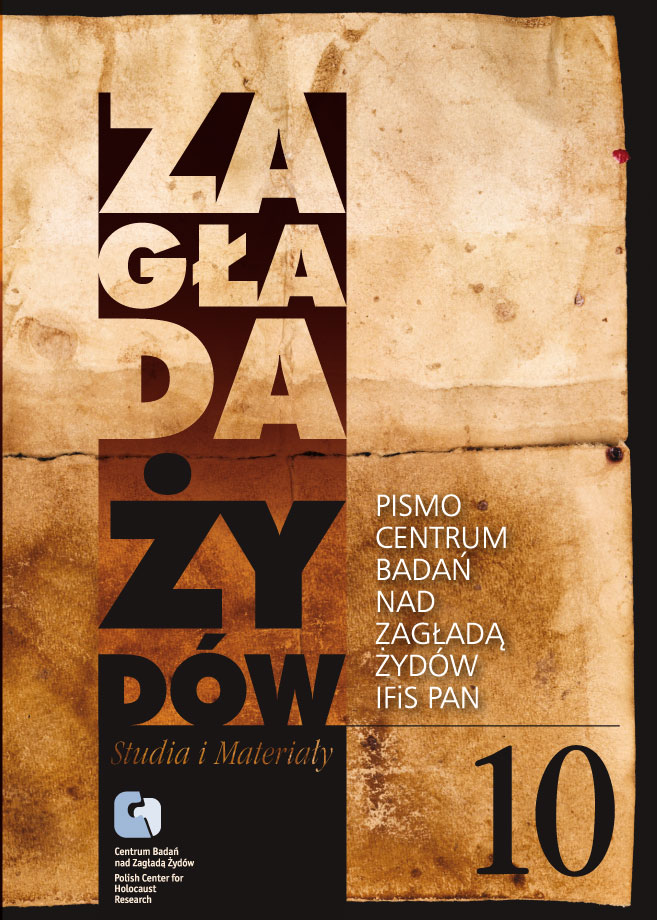Krzesiny i Kreising – między pamiętaniem a pomijaniem. Polskie miasteczko wobec historii, pamięci i rywalizacji w cierpieniu
Zagłada Żydów. Studia i Materiały, Nr 10 (2014), Strony: 443-461
Data zgłoszenia: 2020-10-22Data publikacji: 2014-12-01
 https://doi.org/10.32927/ZZSiM.532
https://doi.org/10.32927/ZZSiM.532
Abstrakt
The area around Krzesiny, located near the city of Poznań, Poland, witnessed several dark events during World War II: Germans oppressed the local population, culminating in a terrorizing action dubbed “akcja krzesińska;” also, a forced labor camp, named “Kreising,” was built near the township, housing mainly Jews. After the war, the suffering in Krzesiny was remembered, but selectively – “akcja” and other forms of Polish suffering were commemorated, while the camp was not. By exploring the “lieux de mémoire” in Krzesiny – dynamics of memory in a small township in Poland – this paper uses localized research to address the issue of gaps in collective memory and commemoration. We briefly look at the relevant history, Polish memory regarding wartime events in Krzesiny, and the postwar dynamics of collective memory. Discussing the latter, we identify a new phenomenon at work, one which we dub “collective disregard” – group neglect of the past of the “Other” that occurs without clear intent. We argue that “collective disregard” is an issue that naturally occurs in the dynamics of memory. By making a deliberate investment in balanced remembrance and commemoration, societies can counter the tendencies of “disregard” and curb the controversies of competitive victimization claims, also called “competitive martyrdom”.
Licencja
Prawa autorskie (c) 2014 Autor&"Zagłada Żydów. Studia i Materiały"

Utwór dostępny jest na licencji Creative Commons Uznanie autorstwa 4.0 Międzynarodowe.
https://creativecommons.org/licenses/by/4.0
Czasopismo publikowane jest w standardzie Diamond Open Access na licencji CC-BY-4.0 Deed - Uznanie autorstwa 4.0 Międzynarodowa - Creative Commons
Podobne artykuły
- Adam Sitarek, „Nie myśl, że to pisze obłąkany”. Listy rabina z Grabowa i jego misja informowania o Zagładzie , Zagłada Żydów. Studia i Materiały: Nr 15 (2019)
- Jan Grabowski, Lea Balint, The Diary of Hinda and Chanina Malachi , Zagłada Żydów. Studia i Materiały: 2008: Holocaust Studies and Materials
- Joanna Nalewajko-Kulikov, Three Colors: Grey Study for a Portrait of Bernard Mark , Zagłada Żydów. Studia i Materiały: 2010: Holocaust Studies and Materials
- Robert Kuwałek, Muzeum-Miejsce Pamięci w Bełżcu – w rok po rozpoczęciu działalności , Zagłada Żydów. Studia i Materiały: Nr 1 (2005)
- Alina Skibinska, Dariusz Libionka, „Przysięgam walczyć o wolną i potężną Polskę, wykonywać rozkazy przełożonych, tak mi dopomóż Bóg”. Żydzi w AK. Epizod z Ostrowca Świętokrzyskiego , Zagłada Żydów. Studia i Materiały: Nr 4 (2008)
- Jurij Radchenko, Popularnonaukowa propaganda i „walka z mitami”: stosunki ukraińsko-żydowskie w XX w. w tekstach Wołodymyra Wjatrowycza , Zagłada Żydów. Studia i Materiały: Nr 12 (2016)
- Justyna Gregorowicz, Komunikacja telefoniczna w życiu społeczności getta warszawskiego , Zagłada Żydów. Studia i Materiały: Nr 10 (2014)
- Jerzy Kochanowski, Żydowskie listy do Hansa Franka (1940): sprzeciw czy strategia przetrwania? , Zagłada Żydów. Studia i Materiały: Nr 9 (2013)
- Marian Turski, „Więcej nic nie powiem…” Rozmowa z Marianem Turskim – ocalałym z getta łódzkiego – przeprowadzona 28 sierpnia 2019 r. w przeddzień obchodów 75. rocznicy likwidacji getta łódzkiego , Zagłada Żydów. Studia i Materiały: Nr 16 (2020)
- Bartłomiej Krupa, Critical History and its ‘Shadow Cabinet’. Polish Historiography and the Holocaust during 2003–2013 , Zagłada Żydów. Studia i Materiały: Nr Holocaust Studies and Materials (2017)
<< < 3 4 5 6 7 8 9 10 11 12 13 14 15 16 17 18 19 20 21 22 23 24 25 26 27 28 29 30 31 32 33 34 > >>
Możesz również Rozpocznij zaawansowane wyszukiwanie podobieństw dla tego artykułu.
 English
English
 Język Polski
Język Polski




